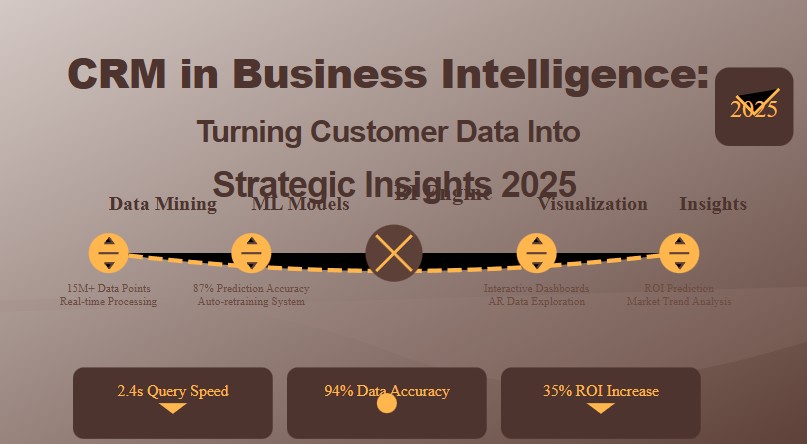In the era of data-driven decisions, information is no longer just power — it’s profit. Businesses that thrive today are those that turn raw data into actionable intelligence. At the intersection of this transformation lies the powerful integration of CRM (Customer Relationship Management) systems with Business Intelligence (BI) tools.
When CRM and BI work together, companies can move beyond storing customer data to analyzing, forecasting, and optimizing every touchpoint in the customer journey.
In this in-depth guide, we explore:
-
🔹 What CRM and BI integration means
-
🔹 Benefits of combining CRM with business intelligence
-
🔹 Key features that unlock value
-
🔹 Use cases across industries
-
🔹 Tools and platforms that power CRM-BI synergy
-
🔹 Implementation steps and strategies
-
🔹 Real-world results and trends in 2025
Let’s uncover how CRM fuels strategic decision-making in modern business intelligence systems. 🧠📊
Table of Contents
💡 What Is CRM in Business Intelligence?
CRM (Customer Relationship Management) tools are designed to capture, manage, and track customer interactions, preferences, behaviors, and purchases.
BI (Business Intelligence) tools analyze data from various sources and turn them into visual dashboards, trend predictions, and actionable insights.
By integrating CRM with BI, companies can:
“Translate customer interactions into patterns, predictions, and performance-enhancing strategies.”
This combination allows leaders to understand not just what is happening with their customers — but why — and what to do next.
🎯 Why Integrating CRM with BI Matters
Here’s why CRM is a goldmine of business intelligence:
| CRM Insight | BI Value Unlocked |
|---|---|
| Customer profiles | Segment audiences by behavior, geography, industry |
| Lead tracking | Identify bottlenecks in the sales funnel |
| Purchase history | Forecast demand and personalize offers |
| Customer service tickets | Analyze root causes of churn or dissatisfaction |
| Campaign response | Track ROI on marketing spend |
| Sales rep performance | Benchmark KPIs and identify training needs |
🔍 Key Benefits of Using CRM in Business Intelligence
✅ 1. Customer Segmentation and Targeting
Use CRM data to break down customers into intelligent groups based on:
-
Lifecycle stage
-
Purchase behavior
-
Location
-
Industry
-
Lead source
BI dashboards visualize these segments, allowing hyper-targeted campaigns.
✅ 2. Sales Funnel Analysis
Track leads from first contact to final conversion. Identify:
-
High-performing reps
-
Stalled opportunities
-
Conversion drop-off points
-
Optimal lead sources
🧠 BI lets you forecast sales more accurately with CRM lead data.
✅ 3. Customer Lifetime Value (CLV) Tracking
Determine which customers bring the most value over time. Use this to:
-
Prioritize loyalty programs
-
Allocate marketing budget
-
Predict high-value prospects
CRM feeds in purchase and engagement data; BI calculates lifetime value curves.
✅ 4. Churn Prediction and Retention Planning
By analyzing support tickets, engagement drops, or negative feedback, BI tools can:
-
Alert account managers
-
Recommend retention campaigns
-
Predict churn risk per customer
CRM provides the “story”; BI delivers the alert and insight.
✅ 5. Campaign ROI Analysis
CRM tracks email opens, clicks, and sales. BI matches this with ad spend, time of day, and channel attribution.
End result?
👉 Better marketing decisions
👉 Higher ROI
👉 Data-backed strategy
🧰 Key Features to Enable CRM x BI Synergy
| Feature | Description |
|---|---|
| Data Warehouse Integration | Centralize data from CRM, ERP, and other systems |
| Real-Time Dashboards | Visualize sales and service trends instantly |
| Predictive Analytics | Forecast revenue, churn, upsell opportunities |
| Drill-Down Reports | Slice metrics by team, time, product |
| Role-Based Access | Secure, relevant data for each team/leader |
| Self-Service BI Portals | Let non-tech users explore CRM data via friendly interfaces |
🔗 CRM and BI Tools: Best of Breed Combinations
| CRM Tool | BI Partner/Integration | Resulting Power |
|---|---|---|
| Salesforce | Tableau (native), Power BI | Advanced customer dashboards and Einstein insights |
| Microsoft Dynamics | Power BI (native) | End-to-end sales & service analysis |
| HubSpot | Databox, Looker Studio | Marketing + sales alignment in one view |
| Zoho CRM | Zoho Analytics | Built-in reports, dashboards, and predictive AI |
| Pipedrive | Google Looker Studio, ClicData | Visual funnel tracking, win/loss analysis |
| Oracle CX | Oracle Analytics Cloud | Real-time churn prevention and revenue forecasting |
🧠 Real-World Use Case
Company: NovaHealth (National Healthcare Provider)
Challenge: Disconnected patient CRM data from call centers, web portals, and billing
Solution:
-
Integrated Salesforce Health Cloud with Tableau
-
Built BI dashboards to track patient satisfaction, rep response times, and care journey
-
Used AI modeling to predict likelihood of readmission
Results:
-
22% decrease in patient churn
-
37% faster response to patient inquiries
-
Millions saved via early intervention on high-risk patients
📈 BI-Driven Metrics to Track From CRM Data
-
🧭 Lead-to-Close Rate
-
⏳ Average Sales Cycle Duration
-
💰 Customer Acquisition Cost (CAC)
-
🏆 Customer Lifetime Value (CLV)
-
📥 Campaign Conversion Rate
-
😡 Net Promoter Score (NPS)
-
📞 Average Time to Resolve Support Tickets
-
🛠️ Re-engagement Campaign Success
🛠️ How to Implement CRM x BI Integration (Step-by-Step)
Step 1: Define Your Business Goals
What do you want to improve? Sales? Retention? Rep performance?
Step 2: Choose Tools That Integrate
Use CRMs and BI platforms that sync natively or via API/middleware.
Step 3: Centralize the Data
Use a Data Warehouse or integration tool (like Zapier, Make, Fivetran) to funnel CRM data.
Step 4: Build Dashboards
Use Power BI, Tableau, or your BI tool of choice to build dashboards that show:
-
KPIs
-
Trends
-
Alerts
-
Forecasts
Step 5: Train & Enable Users
Help sales, marketing, and execs use the insights — not just view them.
Step 6: Optimize Monthly
Review dashboard usage. Adjust metrics. Add new visualizations as needed.
🔮 Future Trends: The Rise of Intelligent CRM in BI
| Trend | What It Means |
|---|---|
| 🧠 Embedded AI Recommendations | CRM data used to suggest next actions in BI reports |
| 🧩 Unified Data Platforms (CDP + CRM) | Combine behavioral, purchase, and support data for full view |
| 🗣️ Voice & Chat-Based BI Tools | Ask your BI: “How were sales last month?” — and get spoken reply |
| 🔐 Data Privacy and Compliance | GDPR/CCPA-compliant dashboards and data lineage tracking |
| 🏭 Industry-Specific Templates | Pre-built CRM dashboards for healthcare, finance, SaaS, etc. |
🎯 Final Thoughts: CRM + BI = Intelligent Growth
CRM systems are the engine of customer interaction, but Business Intelligence is the steering wheel. When used together, they provide:
-
Better decisions
-
Faster response
-
Personalized service
-
Higher revenue
-
Smarter forecasting
Whether you’re a startup or a Fortune 500, integrating CRM into your BI strategy is the key to unlocking intelligent growth in 2025.
“The smartest companies don’t just collect data. They turn CRM activity into business clarity.”




